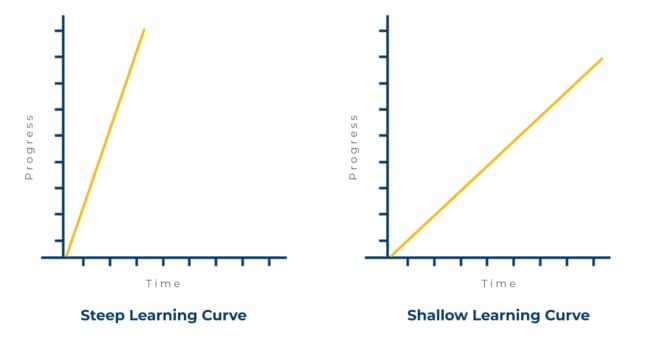How to make CRM user adoption learning curves a lot less steeper
Learning is a given when it comes to trying new things. If your company is deciding to, or has recently invested in a CRM, then you must know that it requires its users to learn it. However, it’s not as easy as memorizing ABCs. Many CRMs boast of a simple, easy-to-use interface, and yes, it can be helpful, but most of the time it’s not the system itself that’s hard to learn. It is the application of CRM as a tool to manage customer relationships and the integration of such into a busy salesperson’s workflow.
Without a plan, learning curves will be steep, yet prone to failure, but first, let’s understand what a steep learning curve is, and why we don’t want that for our CRM adoption process.
What is a Steep Learning Curve?
In colloquial terms, a “Steep Learning Curve” means that the learning process is tedious, difficult, and takes more time. However, the part where it takes more time is wrong. In reality, the learning curve graph shows us the amount of progress over a period of time.
This means that a steep learning curve describes high progress over a short time, whereas a shallow learning curve describes slow progress.
The real question is: Why should we avoid having a Steep Learning Curve in the process of adopting CRM? If the progress and the output comes faster with a steep learning curve, then why shouldn’t we apply it in our user’s CRM training plan?
It may seem like a good thing at first glance, but other than time and progress, there is a third factor that we should also consider, and that is the human factor. Unless your users aren’t going to be humans, the human factor will inevitably affect the course of your company’s CRM adoption. Take a moment to think about how your users will react to a type of training that bombards them with so much information in a very short time, all while they have to handle existing tasks, customers, and doing their actual jobs.
Aside from the time crunch and information overload, you also have to consider what the introduction of CRM is for the user. Most of them probably already have set ways on how to do their jobs, workflows that they are already comfortable with. CRM initiatives set by the management force them to change all that and adopt a new way of doing things. Naturally, change will be hard and CRM users will resist, more so if training is done rashly. It will become hard for users to adapt in such a short period of time, resulting in low adoption rates.
Therefore, Steep Learning Curves are directly proportional to user resistance.
It’s not impossible to succeed using a Steep learning curve model, but just remember that it’s a high-risk, high reward kind of plan. It’s unstable, and can easily result in CRM failure.
A shallow Learning Curve, however, can be more sustainable in the long run. Giving your users enough time to fully digest all that information can lead to a better understanding of the system, and how to apply it in the field. It will also meet less user resistance because there is less pressure to learn CRM right away. However, it shouldn’t be too shallow, to avoid unnecessarily prolonging the learning process. Balance is the key, along with proper timing.
Here are a few tips on how to effectively apply the shallow learning curve approach in your team’s CRM training:
Demonstrate CRM value for the User
From the very beginning, inform your users regarding the idea of using CRM. Involve them in the process so they know what to expect. Moreover, explain what’s in it for them, if they use CRM. Many times, the management focuses on what the company gains when CRM is adopted, and the benefits for the users are not emphasized when in fact, the company can only start seeing results if the users actually utilize the system. It’s important that users fully understand the value of CRM and how it helps them work more efficiently in the long run.
Customized CRM Training
Normally, users will have different roles. Some users will be from sales, some will be from marketing, customer service, and even finance, depending on the company. Instead of teaching everyone everything, training should be specialized for each role. This doesn’t mean that their training should be completely separate. What’s important is to allow each department to focus on what’s necessary for their specific jobs.
Continue with Follow-up Training sessions
Even after the initial training period, after your company has fully adopted the CRM, it’s important to continue having follow-up training sessions. Technology is always evolving and people need to catch up, same goes for the CRM and its users. It’s also an opportunity for them to brush up on their CRM navigation and utilization skills. This can be done annually, quarterly, or monthly, depending on the need for it.
Reduce Manual Data Entry
According to research, manual data entry is the primary reason for the lack of CRM adoption and ironically, 32% of salespeople report that they spend an hour or more per day doing it. Because CRM needs data to run, it’s naturally part of the user’s job to do data entry, even if it’s no fun.
To ease this burden, automated data capturing can be used. An excellent example of this is to utilize a Voice to CRM service. It makes data entry so much easier by simply using one’s voice. The data is then captured, and placed into the right fields. Voice to CRM can also be used to schedule tasks, update user profiles, or even take notes. It efficiently allows users to input data while they’re on the go and increases adoption overall.
CRM is a great platform that can increase your company’s sales, performance, and relationships with customers, but the process of actually integrating CRM into your company can be challenging. Fortunately, with a sustainable training strategy, open communication, and empathy for your users, the road to adoption can become a lot easier. Instead of hastily training users, prioritize an appropriate, time-bound, yet full, CRM user adoption.



